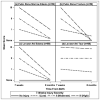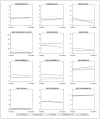Evaluating maternal recovery from labor and delivery: bone and levator ani injuries
- PMID: 25957022
- PMCID: PMC4519404
- DOI: 10.1016/j.ajog.2015.05.001
Evaluating maternal recovery from labor and delivery: bone and levator ani injuries
Abstract
Objective: We sought to describe occurrence, recovery, and consequences of musculoskeletal (MSK) injuries in women at risk for childbirth-related pelvic floor injury at first vaginal birth.
Study design: Evaluating Maternal Recovery from Labor and Delivery is a longitudinal cohort design study of women recruited early postbirth and followed over time. We report here on 68 women who had birth-related risk factors for levator ani (LA) muscle injury, including long second stage, anal tears, and/or older maternal age, and who were evaluated by MSK magnetic resonance imaging at both 7 weeks and 8 months' postpartum. We categorized magnitude of injury by extent of bone marrow edema, pubic bone fracture, LA muscle edema, and LA muscle tear. We also measured the force of LA muscle contraction, urethral pressure, pelvic organ prolapse, and incontinence.
Results: In this higher-risk sample, 66% (39/59) had pubic bone marrow edema, 29% (17/59) had subcortical fracture, 90% (53/59) had LA muscle edema, and 41% (28/68) had low-grade or greater LA tear 7 weeks' postpartum. The magnitude of LA muscle tear did not substantially change by 8 months' postpartum (P = .86), but LA muscle edema and bone injuries showed total or near total resolution (P < .05). The magnitude of unresolved MSK injuries correlated with magnitude of reduced LA muscle force and posterior vaginal wall descent (P < .05) but not with urethral pressure, volume of demonstrable stress incontinence, or self-report of incontinence severity (P > .05).
Conclusion: Pubic bone edema and subcortical fracture and LA muscle injury are common when studied in women with certain risk factors. The bony abnormalities resolve, but levator tear does not, and is associated with levator weakness and posterior-vaginal wall descent.
Keywords: levator ani; magnetic resonance imaging; musculoskeletal injuries; pelvic floor; vaginal birth.
Copyright © 2015 Elsevier Inc. All rights reserved.
Conflict of interest statement
Figures



Comment in
-
New directions in understanding how the pelvic floor prepares for and recovers from vaginal delivery.Am J Obstet Gynecol. 2015 Aug;213(2):121-2. doi: 10.1016/j.ajog.2015.05.016. Am J Obstet Gynecol. 2015. PMID: 26216178 No abstract available.
References
Publication types
MeSH terms
Grants and funding
LinkOut - more resources
Full Text Sources
Other Literature Sources
Medical

